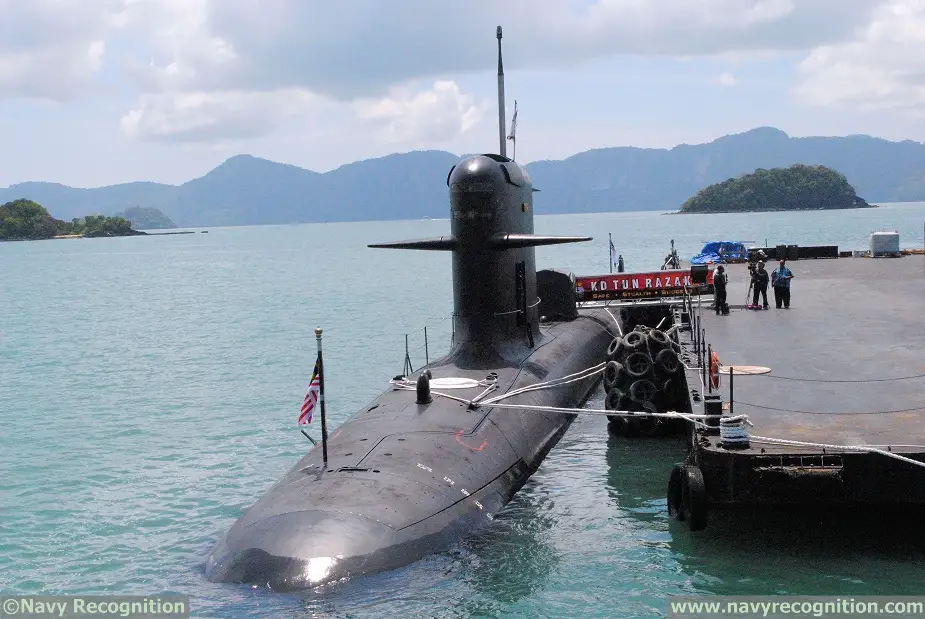The Royal Malaysian Navy (RMN or TLDM for Tentera Laut Diraja Malaysia) plans to procure another submarine in the 14th Malaysia Plan (2031 – 2035) and one more in the 15th Malaysia Plan (2036 – 2040) as part of its "15 to 5" Transformation Plan. The announcement was made recently by Admiral Tan Sri Ahmad Kamarulzaman, the Chief of the RMN, during a change of command at the RMN’s Submarine Command Headquarters in Kota Kinabalu (the capital of Malaysia’s Sabah state in the northern part of the island of Borneo).

Royal Malaysian Navy Scorpene-class submarine (SSK) KD Tun Razak

Royal Malaysian Navy Scorpene-class submarine (SSK) KD Tun Razak
The Royal Malaysian Navy Public Relation Cell shared the following translated statement about the Submarine Force Commander Handover Ceremony:
1. KOTA KINABALU, 26 Feb 18 – The handover ceremony of Submarine Force Commander between Captain Abdullah Sani bin Ismail RMN and Rear Admiral Zulhelmy bin Ithnain was held at the Submarine Force Command Auditorium and was witnessed by the Chief of Navy, Admiral Tan Sri Ahmad Kamarulzaman bin Hj Ahmad Badaruddin.
1. KOTA KINABALU, 26 Feb 18 – The handover ceremony of Submarine Force Commander between Captain Abdullah Sani bin Ismail RMN and Rear Admiral Zulhelmy bin Ithnain was held at the Submarine Force Command Auditorium and was witnessed by the Chief of Navy, Admiral Tan Sri Ahmad Kamarulzaman bin Hj Ahmad Badaruddin.
2. As the new Submarine Force Commander, Rear Admiral Zulhelmy bin Ithnain will shoulder the responsibility of ensuring the readiness of the country’s strategic assets in protecting the nation’s maritime borders. Having the submarines in the RMN’s fleet has increased its capabilities in line with the country’s maritime defence strategic requirements. The government’s investment in procuring the submarines is generally seen as beneficial in upholding maritime security as well as contributing to the nation’s economy, particularly with regards to the maritime claims in the South China Sea.
3. The RMN Transformation Plan 15to5, the RMN plans to procure another submarine in the 14th Malaysia Plan (2031 – 2035) and one more in the 15th Malaysia Plan (2036 – 2040). The RMN fleet modernisation’s long-term plan also included procurement of other surface vessels to strengthen its capabilities in modern warfare.
4. During the same event, nine trainees were awarded with the RMN Submarine insignias after successfully passing their basic training course at the Submarine Training Centre. The training centre is a complete training facility for submariners with systematic syllabus and local teaching staff and has produced Malaysian submariners on par with those trained in more developed countries. The facility has also reduced drastically the cost to train submariners by 75 per cent when compared to having them being sent overseas.
5. In addition, the Government also assists in developing the defence industry through the construction of submarine refit facility as well as developing submarine maintenance capabilities. The refit facility was built in partnership between local company Boustead Naval Shipyard and DCNS, the French Scorpene submarine builder. The partnership has resulted in technology and expertise transfers to Malaysian companies and vendors who conduct the repair, scheduled maintenance and submarine refit fully in Kota Kinabalu.
6. The long-term planning currently being done would be able to boost the RMN’s capabilities as well as give returns or dividends to the country. The RMN as the main maritime enforcement agency shoulders the responsibility of ensuring the safety of Malaysian waters, including in eastern Sabah Because of fiscal challenges and the geopolitics situation in the South East Asia region, Admiral Kamarulzaman is rolling out a new transformation and modernization plan called "15 to 5". There are currently 15 classes of ships in the RMN, coming from 7 nations with an average age of 30 years. This represents a large costs in terms of maintenance and operations. As a solution the "15 to 5" plan calls for:
1 - Phasing out of the older vessels in the fleet. This would lead to optimized resources.
2 - Improving procurement processes (reduced and optimized procurement requirements, reduced ill practices) would lead to additional savings for the RMN.
3 - Use these savings to fund the "15 to 5" plan, while focusing on local shipyards and defence industry.
2 - Improving procurement processes (reduced and optimized procurement requirements, reduced ill practices) would lead to additional savings for the RMN.
3 - Use these savings to fund the "15 to 5" plan, while focusing on local shipyards and defence industry.
The five classes that would form the Royal Malaysian Navy would be:
» New Generation Patrol Vessel (Kedah-class)
» Littoral Combat Ship (Gowind-class)
» Littoral Mission Ship (able to do 80% of the LCS class missions at 20% of the cost)
» Multirole Supply Ship
» Submarines (Scorpene-class)
» New Generation Patrol Vessel (Kedah-class)
» Littoral Combat Ship (Gowind-class)
» Littoral Mission Ship (able to do 80% of the LCS class missions at 20% of the cost)
» Multirole Supply Ship
» Submarines (Scorpene-class)
The RMN fleet would remain at 55 vessels meaning some additional procurement even among existing classes (such as the Scorpene-class submarines, two of which are already deployed by Malaysia).

No comments:
Post a Comment